It’s impossible to imagine a world without Keith Richards’ three-note strut in “Satisfaction” or Jimmy Page’s chugging wonder in “Whole Lotta Love”? As a repetitive, melodic hook, a well-written guitar riff can make a song unforgettable.

They have shaped genres, immortalized musicians, and inspired a generation of guitarists. A riff doesn’t even have to be very complex or chock-full of techniques. In fact, some of the catchiest songs across genres have been anchored by simple but effective riffs. Below, we share many easy guitar riffs that you’ll have a lot of fun learning.
1. Seven Nation Army by The White Stripes
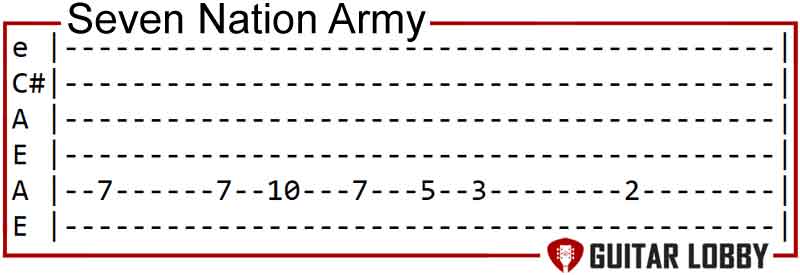
Tabs: See Seven Nation Army by The White Stripes Tabs Here
This riff is instantly identifiable. Even those who aren’t into rock but frequent sporting events would have heard it for sure. Here’s the interesting bit: the descending bass riff was actually played on a tuned-down Kay semi-hollow body guitar using effects like a whammy pedal.
Tips to Practice:
Here’s how you play this riff in the easiest way possible: place your first finger on the 7th fret of the A string, play it twice, and move to the 10th fret on the same string. Now, go back to the 7th fret before descending to the 5th fret, followed by the 3rd fret, and finally stopping at the 2nd fret. Yes, there’s a lot of moving around the neck, but it’s all on the same string!
2. Californication by Red Hot Chili Peppers
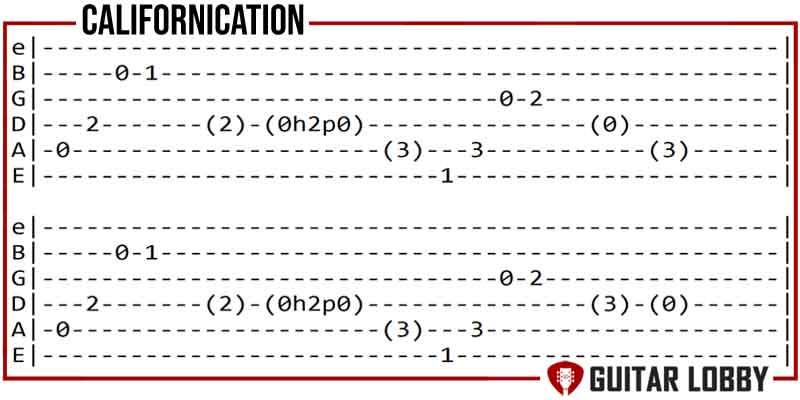
Tabs: See Californication by Red Hot Chili Peppers Tabs Here
Since its release in 1999, this clean-tone riff has been overplayed everywhere, TV, radio, and guitar stores. And why not? It’s simple, melodic, and easily playable. It appears during the verse and is the most memorable part of the song alongside John Frusciante’s killer solo.
Tips to Practice:
The verse riff is built around moving from Am chord to the F power chord. You start by making the A minor chord shape but lift the first finger. This is an Asus2 chord shape. Once you have the shape ready, pluck the 5th string followed by the 4th string. Next, you’ll pluck the 2nd string open and pluck it again after planting your first finger on the first fret. The second part of the riff is just picking the F power chord in the following sequence: 6th string, 5th string, 3rd string open, and 3rd string with the middle finger on the 2nd fret.
3. You Really Got Me by The Kinks
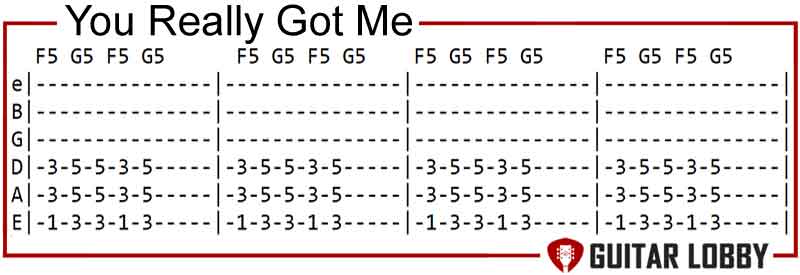
Tabs: See You Really Got Me by The Kinks Tabs Here
Can you imagine this 1964 classic with a saxophone line instead of that imaginative guitar riff? Well, believe it or not, that’s how the band initially wrote it, but thankfully ditched the saxophone solo for a guitar riff. Dave Davies’ distorted work of art ended up becoming one of the most iconic riffs in rock n roll – so much so that the song is a rite of passage for mastering power chords.
Tips to Practice:
The simplest way to play the riff is on one string – the thickest E string. Place your first finger on the 1st fret and then slide it down to the 3rd fret. You’ll need to go back and forth between the two frets, fast and without lifting your finger. The way Davies plays it is a lot trickier, and you can give it a shot once you’ve perfected this version.
4. Rebel Rebel by David Bowie
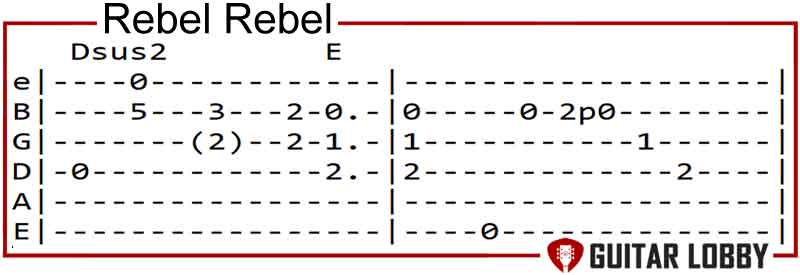
Tabs: See Rebel Rebel by David Bowie Tabs Here
This jangly riff sounds like it came out of Rolling Stones’ vault! It wasn’t accidental but intentional. David Bowie wanted Rebel Rebel to be – a catchy track with a central riff that sounds as if Keith Richards played it. Lucky for us, the riff is super simple to play and repeats throughout the song.
Tips to Practice:
You just need two chords to get this riff under your belt: Dsus2, which is nothing but a D major chord minus a note, and E major. You’ll only be picking notes out of two chords but make sure you let the strings ring out to sound like the original. The good news is that you’ve mastered the repetitive riff; you’ve pretty much nailed the entire song.
5. Smoke on the Water by Deep Purple
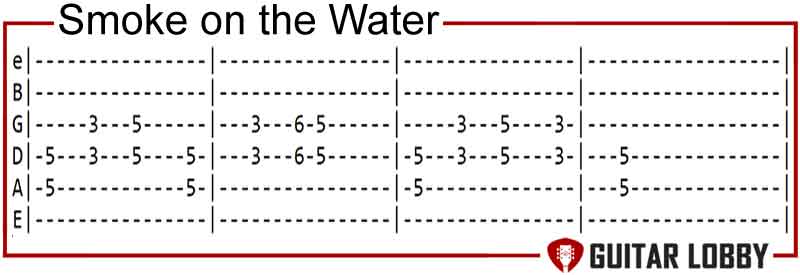
Tabs: See Smoke on the Water by Deep Purple Tabs Here
It’s no accident that the adrenaline-pumping riff that opens “Smoke on the Water,” a 1972 smash hit by Deep Purple, is usually one of the first ones a guitarist learns. It’s catchy, repetitive, and has been simplified to a novice level. In other words, anyone, regardless of their skill level, can crack it in a matter of minutes.
Tips to Practice:
The band’s guitarist Ritchie Blackmore based the riff on Beethoven’s Fifth Symphony and used parallel intervals to play it. But new guitar players can recreate it using root notes of the power chords. If you want to sound closer to the record, ditch the pick and use your first two fingers to pluck the third and fourth strings as loudly as you can.
6. Back in Black AC/DC
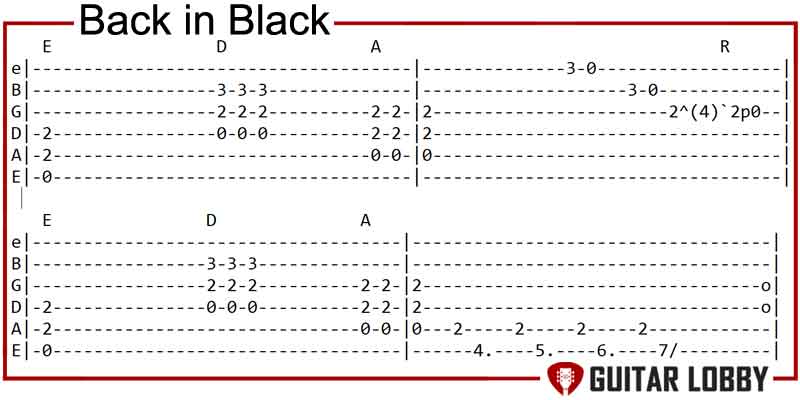
Tabs: See Back in Black AC/DC Tabs Here
The iconic guitar duo Angus and Malcolm Young of AC/DC have gifted the world some of the most unforgettable and earth-shaking riffs, one of which features in the band’s best-selling “Back in Black.”The song was written as a homage to the band’s founding vocalist Bon Scott after his untimely death. The opening riff is nothing short of legendary, but it’s also accessible to guitar students who don’t have too many techniques under their belt.
Tips to Practice:
This riff is made up of chords and single-note picking. The chords you’ll use here are E major, D major, and A major, and the notes you’ll pluck will come from these. I also recommend watching a few tutorials to familiarize yourself with E minor pentatonic scale to learn the bluesy lick that makes up the second part of the riff.
7. Are You Gonna Be My Girl by Jet
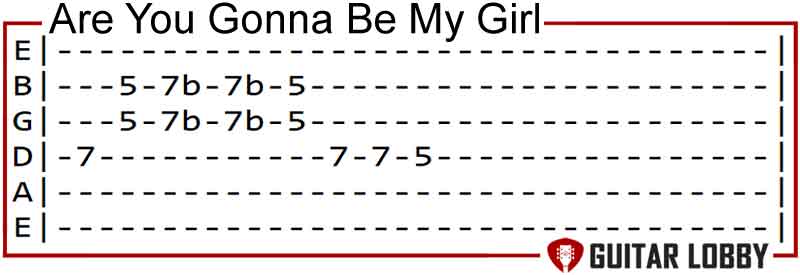
Tabs: See Are You Gonna Be My Girl by Jet Tabs Here
Playful, energetic, and designed to get the crowd going – that sums up the main lick of Jet’s breakout hit. The dynamic riff, along with the catchy Motown beats of “Are You Gonna Be My Girl,” put the Aussie rockers on the map.
Tips to Practice:
You’ll be sliding and jumping between the 5th and the 7th frets. There are some double stops, string bending, and pull-offs involved. Not too challenging for anyone willing to add it to their practice routine. You can bend the strings by either pulling them down or pushing them up. Just make sure you rotate your wrist correctly when you do that if you want your riff to sound like the one in the record.
8. Whole Lotta Love by Led Zeppelin
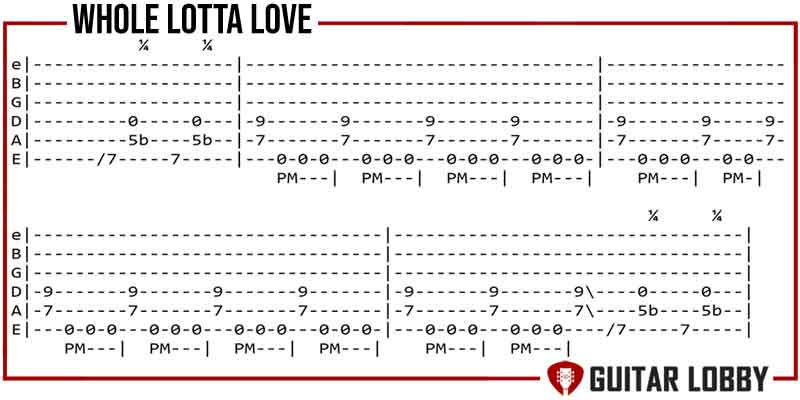
Tabs: See Whole Lotta Love by Led Zeppelin Tabs Here
Led Zeppelin’s lead guitarist Jimmy Page is the brains and talent behind some of the most revered riffs in rock. The riff in “Whole Lotta Love” may not be Page’s most technically sophisticated, but it’s simple and uplifting and will make a great addition to your arsenal.
Tips to Practice:
This riff is a great exercise in building accuracy and speed, considering the track’s fast rhythm. You’ll not only be picking notes but also playing power chords along with some palm muting. The most beginner-friendly way to play the riff is by placing the third finger on the thickest E string 7th fret and the first finger on the 5th string 5th fret. The tutorial above shows you how to tackle it in an ultra-simple way.
9. (I Can’t Get No) Satisfaction by The Rolling Stones
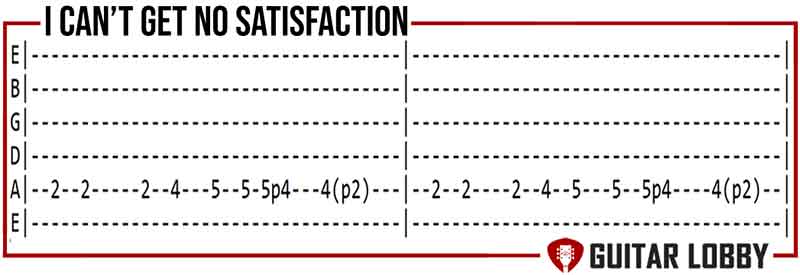
Tabs: See (I Can’t Get No) Satisfaction by The Rolling Stones Tabs Here
You’re looking at one of the most famous riffs ever that comes straight out of one of the most iconic rock n roll tunes. To think that it almost got replaced by horns! I can’t imagine a world where this riff didn’t exist. The groovy, fuzz-drenched riff stays lodged in your head long after the song is over. It came to Keith Richards in his dreams. He woke up and recorded the riff, thinking it could be later replaced by horns. Thankfully, it wasn’t.
Tips to Practice:
I love how this legendary riff is enough to be attempted by absolute beginners. That’s right. It’s made up of three notes. All of them are played on one string: the 5th string. You can use your index, ring finger, and pinky finger to play the notes. The fuzzy tone of this riff was thanks to Richards’ Maestro Fuzz unit. Since it’s a simple riff, getting the tone right is important. You’ll need a fuzz pedal. If you don’t have one, then overdrive or distortion will also work fine. If you’re looking for easy guitar riffs for beginners, this is one that I highly recommend learning. It’s easy and fun to play.
10. Come As You Are by Nirvana
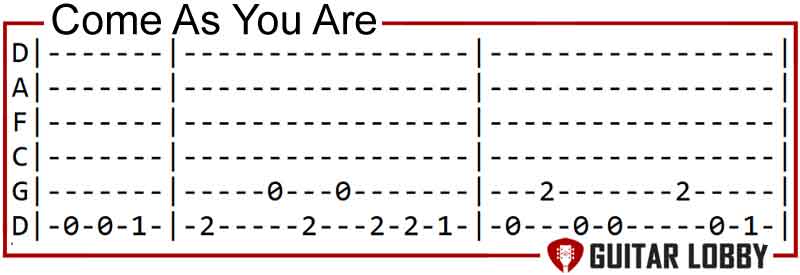
Tabs: See Come As You Are by Nirvana Tabs Here
Rumor has it that Nirvana lifted this riff from or was at least heavily inspired by Killing Joke’s “Eighties.” Regardless, it’s an ultra-catchy hook that puts the grunge pioneers in the bright mainstream spotlight.
Tips to Practice:
What’s great about this riff is that it sounds like there’s a lot going on technique-wise, but it’s actually pretty straightforward. You can play it on an acoustic or electric, and it’ll sound equally awesome. To sound like the original, you’ll need to tune down your guitar a whole step down to D-G-C-F-A-D as in the record. If you want to stick to standard tuning, that’s also fine. A clean tone and letting the notes ring out is important to capture the essence of the original.
11. Psychosocial by Slipknot
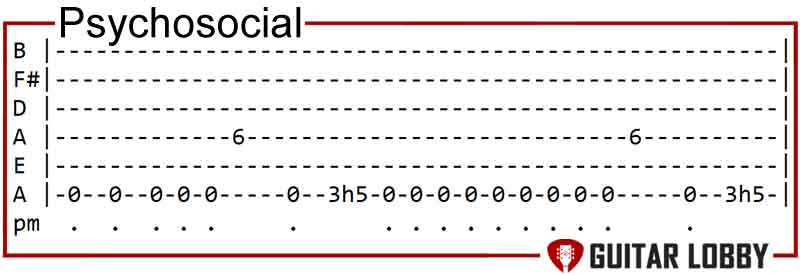
Tabs: See Psychosocial by Slipknot Tabs Here
Here’s a treat for metalheads. A killer riff that might be the easiest one in Slipknot’s entire vault. Psychosocial was released in 2008 and ended up becoming one of the biggest hits for the masked metallers. It even got them a Grammy nomination.
Tips to Practice:
Psychosocial is a riff fest in drop-A tuning. Its alternate tuning is actually a good thing for beginners. Why? Because power chords are incredibly easy in drop A, and this riff is all about big power chords and open-string palm mutes.
12. Enter the Sandman by Metallica
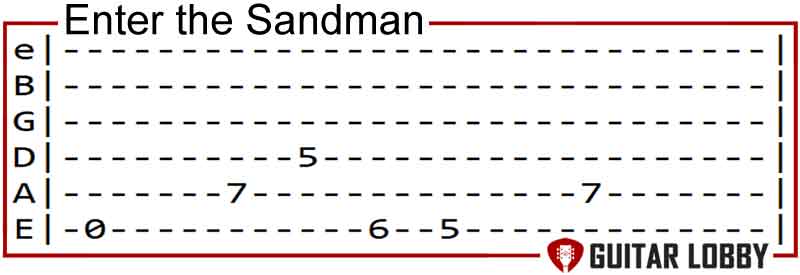
Tabs: See Enter Sandman by Metallica Tabs Here
“Enter the Sandman” is catchy to the core, if not the most technically sophisticated track by the band. In fact, it almost sounds more rock than heavy metal to me. Regardless, the riff-fest catapulted Metallica into permanent mainstream stardom and received plenty of airplay. The ominous riff is also considered playable enough to be attempted by beginner guitarists.
Tips to Practice:
The intro riff is played by Kirk Hamett using a clean electric tone with some chorus effects. It’s big on power chords and palm mutes. It’s a speedy riff involving the E5 power chord. I recommend starting slowly and working on your apace once you’re comfortable with the fingerings and flatpicking the notes. This is definitely one of the easiest guitar riffs to learn.
13. I Feel Fine by The Beatles
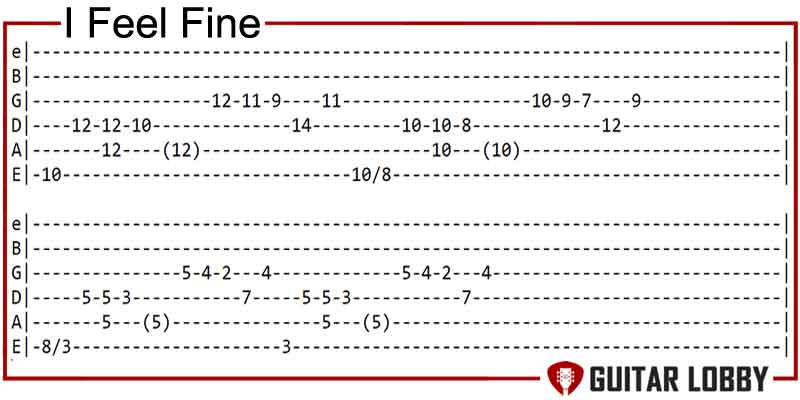
Tabs: See I Feel Fine by The Beatles Tabs Here
In ” I Feel Fine,” the beautiful arpeggiated riffs kick in a few seconds into the song. The song was the result of John Lennon’s desire to create more tunes around big central riffs, even though it meant drawing inspiration from resources around them. In this case, the riff sounds a lot like the one in Bobby Parker’s “Watch Your Step.”
Tips to Practice:
The Beatles gifted the world tons of amazing riffs that were crowd-pleasing and didn’t require tons of techniques to master. But I’ll put this in the league of the more challenging ones, as it requires you to handle barre chords, like the D major barre chords. Since you’ll be dealing with a chord sequence that goes all over the fretboard, I recommend starting slow and working up the tempo as you go.
14. Livin’ on a Prayer by Bon Jovi
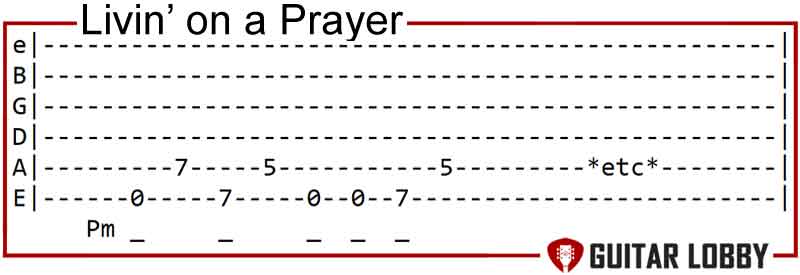
Tabs: See Livin’ on a Prayer by Bon Jovi Tabs Here
The main riff from Bon Jovi’s chart-conquering hit “Livin’ on a Prayer” is a perfect candidate for the list for being impressive to the ears and beginner-friendly. The inspiring ballad was released in the ‘80s, at a time when the American economy was in turmoil, and everyone needed an emotional pick me up.
Tips to Practice:
The riff has a distinctive sound thanks to Richie Sambora’s use of talkbox. It’s based on E, D, and B notes from the E minor pentatonic scale. It’s minimalist, easy to nail, but as impactful as the rest of the track.
15. Sweet Home Alabama by Lynyrd Skynyrd
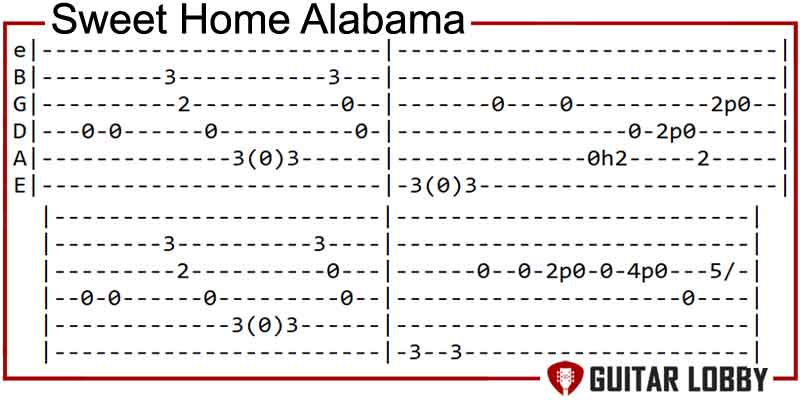
Tabs: See Sweet Home Alabama by Lynyrd Skynyrd Tabs Here
Time for some riffing, country rock style. Lynyrd Skynyrd’s most memorable hit is a favorite among new guitar players for being a catchy three-chord wonder. But give the song a close listen, and you’ll notice there’s plenty of guitar action going beyond the three-chord progressions. The melodic intro riff I am talking about is challenging, but the practice tips below should simplify things a bit.
Tips to Practice:
Start by making a D chord and picking D, D, B, and G strings. Next, make a Cadd9 chord shape and pick the A, A, B, and G strings. Finally, make a G chord and pick E, E, and G strings two times over. There’s a small riff that follows the G chord that involves hammer-ons and pulls-offs. I recommend learning the part as well to complete the intro.
16. I Can’t Explain by The Who
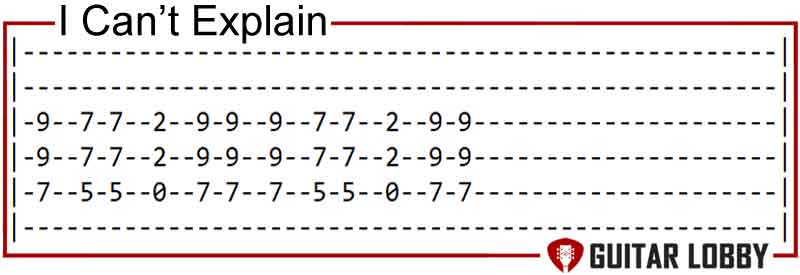
Tabs: See I Can’t Explain by The Who Tabs Here
It’s been close to 60 years since The Who and Pete Townshend became global rock stars, thanks to this unforgettable riff. The song’s success really helped the band fortify their popularity in an era dominated by legends like the Beatles, the Kinks, and the Rolling Stones.
Tips to Practice:
The simplest way to play this riff would be to play E major chord once and the D major chord twice, then hit the A major once and end with the E major chord twice. The pauses in between the chords make it easier for beginners to transition from one chord to another. Once you’ve perfected this arrangement, try out other versions of this riff to practice navigating the fretboard.
17. Smells Like Teen Spirit by Nirvana
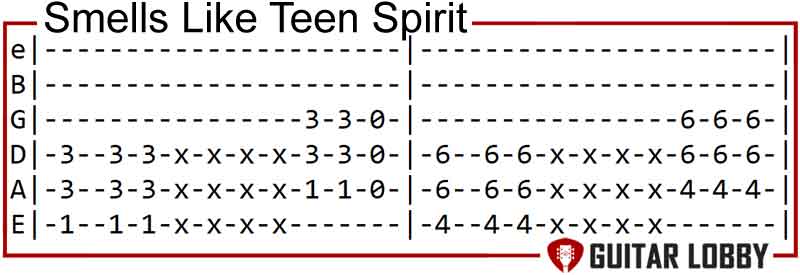
Tabs: See Smells Like Teen Spirit by Nirvana Tabs Here
This might be one of the most, if not the most, famous riff ever written. It swung into motion the rise of grunge and made Kurt Cobain and Nirvana a household name. It’s distinctive and still sounds fresh despite being over three decades old and incredibly overplayed.
Tips to Practice:
The good news is that the iconic riff is made up of only four chords: F5, A#5, G#5, and C#5. The not-so-good part is the slightly tricky strumming pattern and tackling a fast rhythm. You’ll be using a syncopated 16th note strum pattern which requires you to get comfortable with steady picking motion. Try practicing with the original to get the timing right.
18. Rock You Like a Hurricane by Scorpions
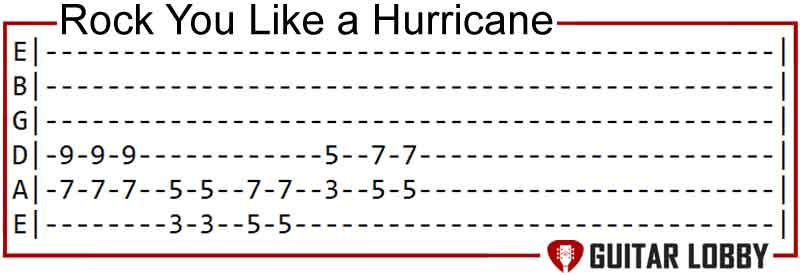
Tabs: See Rock You Like a Hurricane by Scorpions Tabs Here
“Rock You Like a Hurricane” is an excellent song for anyone who wants to go over the basics of power chords. There are three riffs to explore, but the opening riff is my favorite. You could also call it the central riff since it also shows up in the chorus.
Tips to Practice:
It uses extended power chords and is perfect for beginner guitarists. The chords you’ll be tackling here are E5, G5, A5, C5, and D5, repeated four times and ending with an E5. It’s all downstrokes and shouldn’t take you long to master.
19. Twist and Shout by the Beatles
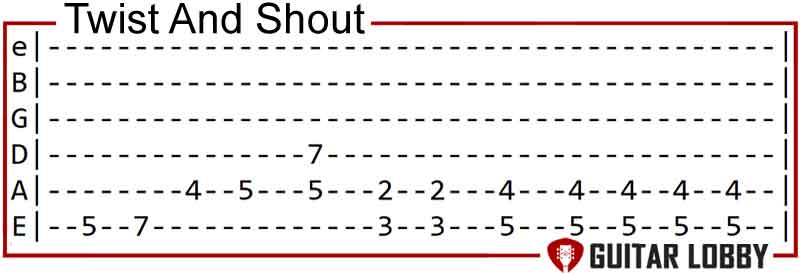
Tabs: See Twist and Shout by the Beatles Tabs Here
“Twist and Shout” isn’t a Beatles original but a cover that went on to become even more famous. It has been touted as “the most famous single take in rock history.” Here’s the interesting bit: even the original record that inspired this track had borrowed generously from another tune. Would you like to know which one? None other than the groove-fest “La Bamba.”
Tips to Practice:
This is a two-bar riff that kicks off with a D power chord followed by the notes in the G power chord shape and finally an A power chord. Remember to position your thumb below the neck for easy stretches and access to all the chord shapes.
20. Running Down a Dream by Tom Petty
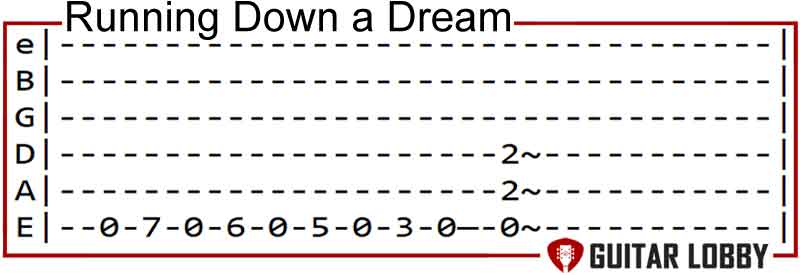
Tabs: See Running Down a Dream by Tom Petty Tabs Here
“Running Down a Dream” is a beautiful song about navigating the ups and downs of life. It’s built around a fantastic riff courtesy of Mike Campbell, the extremely talented guitarist of Tom Petty and the Heartbreakers. Campbell’s signature riff is based on a descending E minor blues scale, which is basically the E minor pentatonic scale with an added note.
Tips to Practice:
The opening riff is super simple, based on the low E string. Start with open E and move to the 7th fret and then go right back to open E. Next, move to the 6th fret and again go back to open E. You repeat the same with the 5th fret and 3rd fret, going back to open E after playing each. In other words, you play open E before and after each of the four notes.
21. Day Tripper by The Beatles
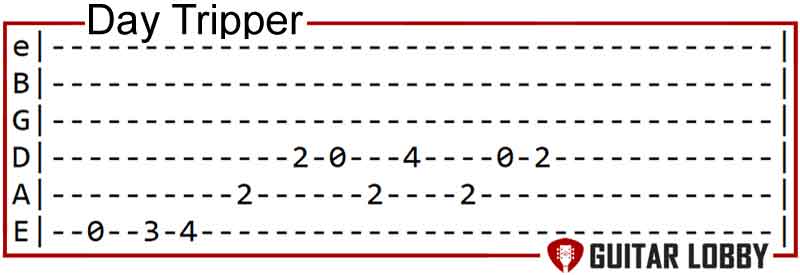
Tabs: See Day Tripper by The Beatles Tabs Here
The primary riff in “Day Tripper” is based on E minor pentatonic and is widely hailed as one of the greatest guitar riffs ever recorded. The two-measure riff repeats throughout the track, driving the entire piece. It starts the song and closes it and gives off a blues meets rock and roll vibe. Easily one of the best Beatles riffs ever!
Tips to Practice:
The riff opens the song and is played on an acoustic as well as electric. So you can pick either while practicing. You can play it using down-picking or alternate picking, depending on what you’re more comfortable with. Although, George Harisson relied only on down-picking. The good news is you won’t have to move up and down the neck, as the riff doesn’t move beyond the first four frets.
22. Sweet Child O’ Mine by Guns ‘N’ Roses
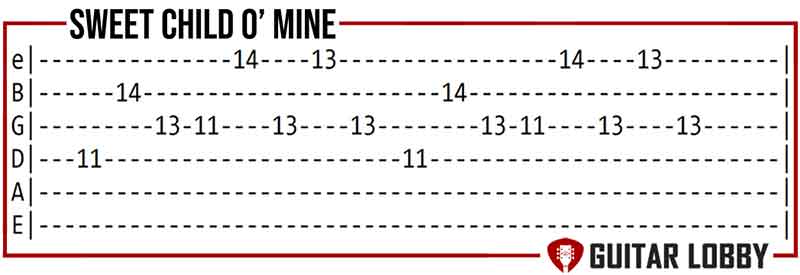
Tabs: See Sweet Child O’ Mine by Guns ‘N’ Roses Tabs Here
When Slash wrote the iconic main riff, he only did it as a string-skipping warm-up exercise. Little did he know that the riff would set in motion the genesis of one of the greatest rock ballads in the history of music.
Tips to Practice:
This riff taps into the string-skipping technique, which is playing notes using non-adjacent strings. The string jumping is the most challenging bit about this E minor pentatonic scale riff. Familiarizing yourself with this scale will make navigating the fretboard for rock riffs and blues licks a breeze. As you can see in the tabs, you’ll need to tune your guitar half a step down to the Eb tuning to play along with the record.
23. Sunshine of Your Love by Cream
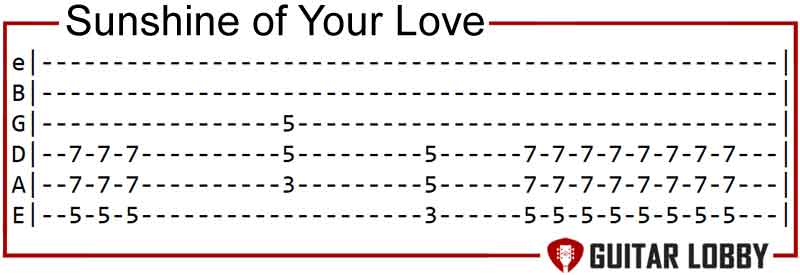
Tabs: See Sunshine of Your Love by Cream Tabs Here
Eric Clapton and Jack Bruce came up with the idea for this riff while watching a Jimi Hendrix concert. Funnily enough, Hendrix later covered the song and made it a staple at his live concerts, clueless that it was inspired by his performance.
Tips to Practice:
The iconic riff revolves around the D blues scale or the D minor pentatonic scale with an additional note. You start from the octave of the first D note or the 12th fret of the 4th string using the third finger and play the note twice. Now use the first finger at the 10th fret of the same string and go back to the first note we played. This is the first part of the riff, and the rest of it is just as straightforward.
24. Eye of the Tiger by Survivor
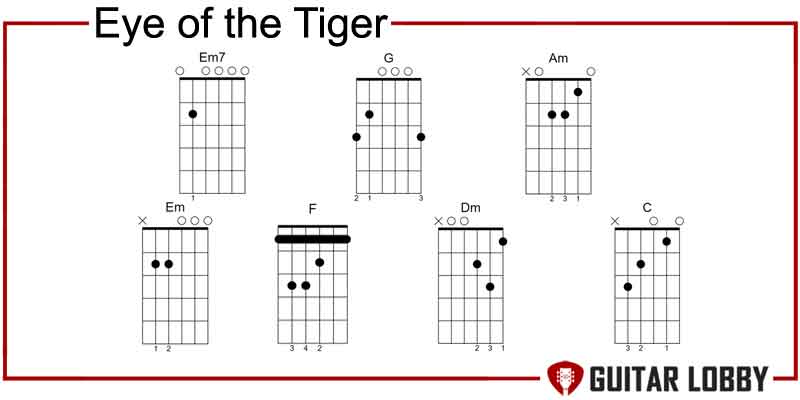
Tabs: See Eye of the Tiger by Survivor Tabs Here
Every time I hear this riff, there’s a rush of adrenaline in my body. It’s almost as iconic as the fictional action hero for which it was written: Rocky Balboa. The riff is the ultimate power chord workout, fuelled by chords: C5, Bb5, G5, and Ab5.
Tips to Practice:
If you listen closely, there’s a slight palm-muted guitar part that kicks in before the power chords. This is just one note being picked really fast. You can recreate it by placing your first finger on the 5th string and 3rd fret and doing quick alternate picking. If you’re new to this style of picking, let this song be your practice jam for adding this useful skill to your arsenal.
25. Redemption Song by Bob Marley
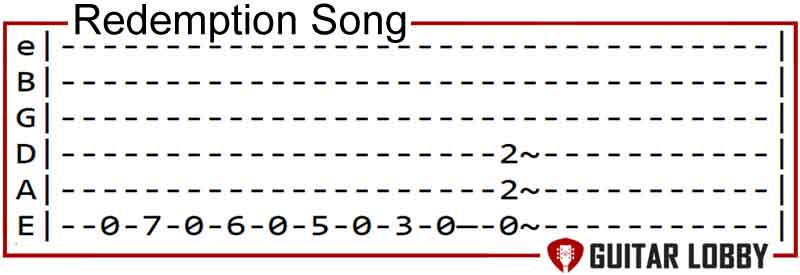
Tabs: See Redemption Song by Bob Marley Tabs Here
Bob Marley and reggae were inextricably intertwined, but this tune didn’t belong to the Jamaican icon’s favorite genre. “Redemption Song” was Marley’s last recording before his death and stood out as a folksy rock ballad in his reggae-led catalog. The distinctive riff that opens the song is perfect for beginners.
Tips to Practice:
The opening riff spans four bars and is built around the G major pentatonic scale. If you know all the notes in this scale, learning the riff should be a cakewalk for you. Unlike the other riffs on this list, this one is played on an acoustic.
26. Beat It by Michael Jackson
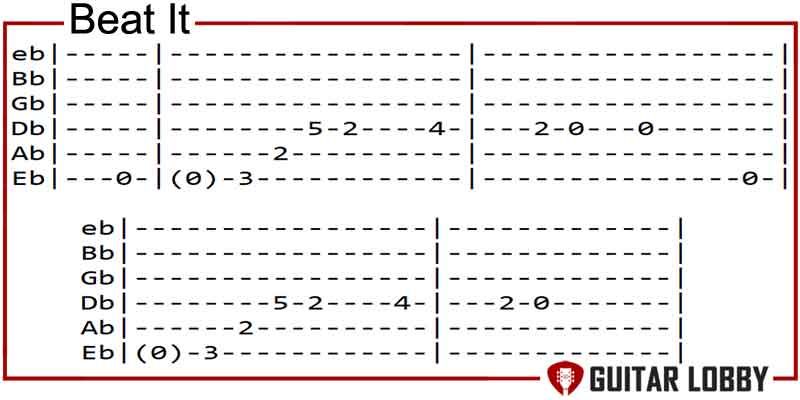
Tabs: See Beat It by Michael Jackson Tabs Here
Michael Jackson’s hard rock-meets-pop adventure is an excellent example of riffs and solos in pop. It was played by Steve Lukather and is tougher than it sounds. But here’s the great part: the cool riff appears multiple times during the track, including the intro and the chorus, and stays pretty much the same. So, once you have it down, all that’s left for you to complete the track is to learn Eddie Van Halen’s epic solo, which is best left for another day.
Tips to Practice:
This riff uses E minor arpeggios and is limited to only three strings: E, A, and D. Although the tempo is slow enough for beginners, the rhythm is slightly tricky, so listen to the record a few times to know how long every note lasts. If you want to play along with the original, make sure you tune down to E flat tuning. You can stick to the standard tuning to learn the riff.
27. Heart of Gold by Neil Young
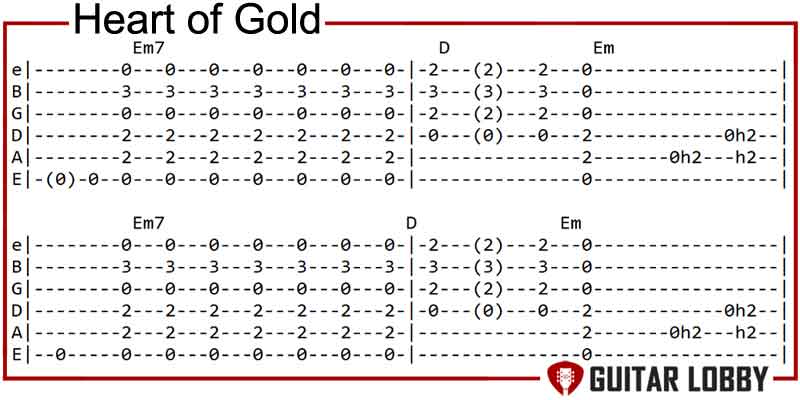
Tabs: See Heart of Gold by Neil Young Tabs Here
Did you know Sweet Home Alabama was intended as a reply to Neil Young’s controversial “Alabama?” But that’s not the song we’ll be exploring here. Young’s Heat of Gold is a better fit for this list, considering its memorable and expressive intro riff made up of chords and melody.
Tips to Practice:
The riff is based around simple chords: Em7, D major, and E minor in all down strums. There’s an embellished lick around the E minor shape with some hammer-ons. You can check the tutorial to see if it’s within your skill level or skip it and get back to it when you’re slightly more proficient.
28. Wild Thing by The Troggs
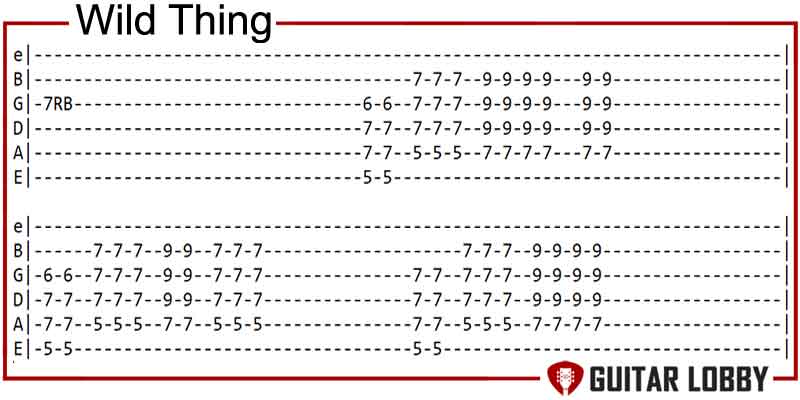
Tabs: See Wild Thing by The Troggs Tabs Here
“Wild Thing” by The Troggs is a case study of creating an iconic tune with minimal music material. If you know your power chords, there’s nothing that can stop you from mastering the classic riff that drives this tune. The riff is timeless, and I bet everyone’s heard it at some point in their lives, from boomers to zoomers.
Tips to Practice:
While the original recording utilizes full barre chord shapes, you can skip that for now and recreate the riff using A5, D5, and E5 power chords. You play the A power chord twice, mute on beat three, and then play the D power chord twice. Now do the same with the E power chord and the D power chord. Playing all these power chords will help you build the dexterity and finger strength you’ll need to tackle tricky barre chords later.
29. Teenage Kicks by The Undertones
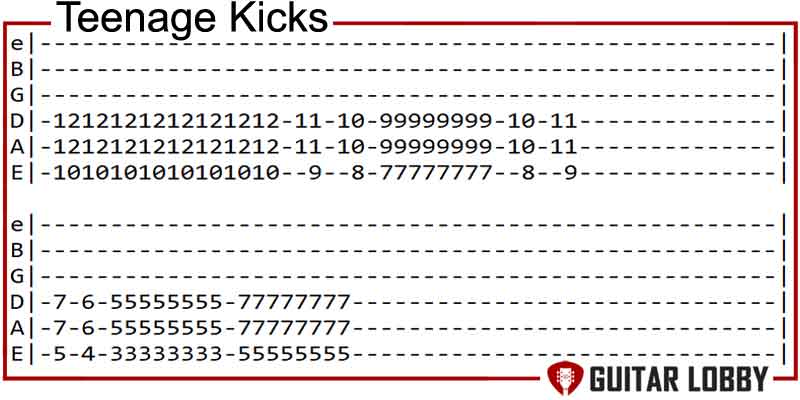
Tabs: See Teenage Kicks by The Undertones Tabs Here
“Teenage Kicks” is a punk-pop classic that got the Northern Irish rock band the attention they deserved. It was their debut, but also their most enduring hit and part of the reason is that amazing riff.
Tips to Practice:
The riff is beginner friendly, but we’re talking about a punk band here, so expect plenty of power chords or barre chords action here. You can play the riff with 5th or 6th-string root power chords or barre chords with all downstrokes. You’ll need some distortion to sound more like the original riff.
30. I Wanna Be Your Dog by Iggy and the Stooges
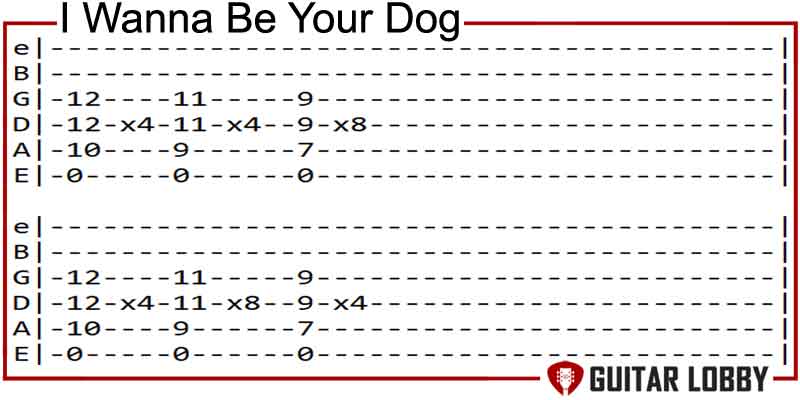
Tabs: See I Wanna Be Your Dog by Iggy and the Stooges Tabs Here
The main riff in Iggy and the Stooges’ “I Wanna Be Your Dog” has become a permanent feature in the greatest guitar riff rankings and polls. The three-chord makeup of G, F#, and E puts it within the reach of new guitar learners. The repetitive riff dominates punk circles to this date.
Tips to Practice:
This a fast-paced power chord riff, so getting the timing right is as essential as figuring out the chords. You can play all three chords with the root note on the 5th string. Another tip that’ll help you nail the unsettling tone of the song is letting the low E string ring. The riff repeats throughout the song. Ace it, and you’ve pretty much nailed the entire track.
31. Chasing Cars by Snow Patrol
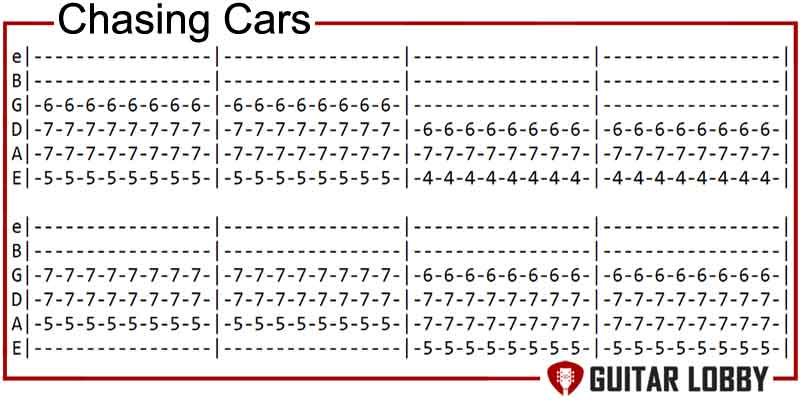
Tabs: See Chasing Cars by Snow Patrol Tabs Here
What can be more crowd-pleasing than playing the riff of one of the most-played radio tunes of the 21st century? Yes, I am talking about Snow Patrol’s heartwarming hit “Chasing Cars.” Everything from the common chord progression, and strumming pattern, to the simple opening riff is great for newbies.
Tips to Practice:
You’ll need an electric with a clean tone to get started with the riff, and make sure you let the notes ring out. Keep the distortion on low, or skip it altogether. The riff taps into a blend of open and fretted notes. Stretching between the frets is going to be a workout, but consistent practice will get you there.
32. Wanted Dead or Alive by Bon Jovi
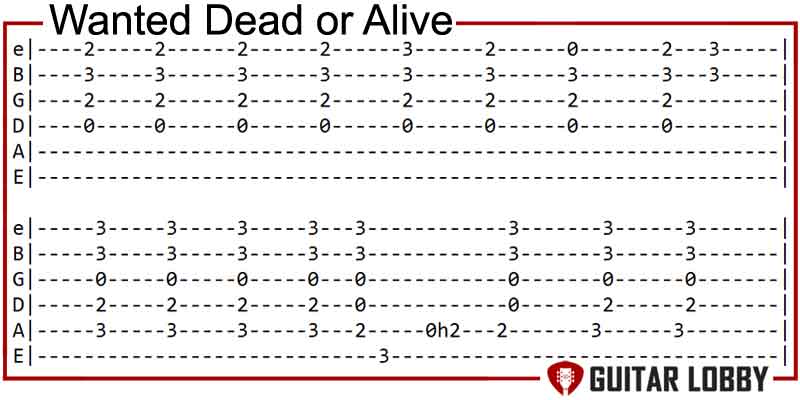
Tabs: See Wanted Dead or Alive by Bon Jovi Tabs Here
Some riffs sound way more complex than they actually are. Those are, hands down, my favorites! And the jingly jangly intro riff from this Bon Jovi classic is one of them. Lyrically, “Wanted Dead or Alive” compared the life of a rock star to an old western outlaw. It became Bon Jovi’s signature song and cemented their place as an influential rock band.
Tips to Practice:
This riff is a fingerpicking exercise involving different shapes down the neck. You’ll also be constantly picking the open D string throughout. The jingly-jangly sound you hear in the record comes from a 12-string acoustic guitar. But don’t let that alarm you. Even your usual 6-string acoustic guitar is good enough to play the riff.
33. Oh, Pretty Woman by Roy Orbison
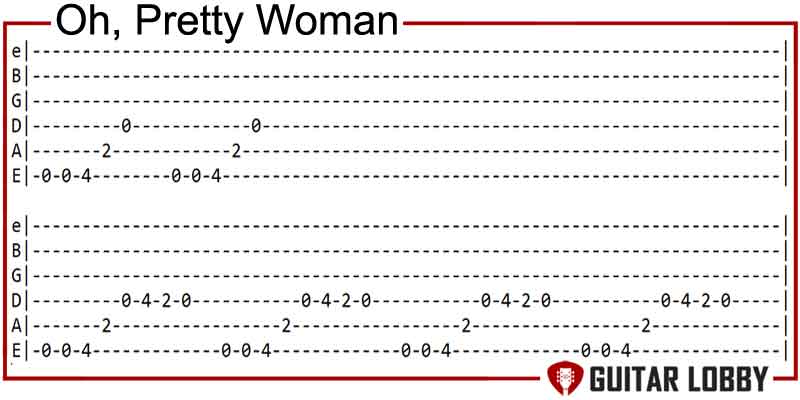
Tabs: See Oh, Pretty Woman by Roy Orbison Tabs Here
Released in 1964, “Oh, Pretty Woman” became Roy Orbison’s biggest hit, containing all elements of a crowd-pleasing tune: a fantastic intro riff, catchy hooks, endearing vocals, and an upbeat tempo. Mercy!
Tips to Practice:
In its most simplified form, the fun riff from Roy Orbison’s “Pretty Woman” only requires one finger. It’s one of the most recognizable acoustic riffs that revolves around an E7 arpeggio. So, get comfortable with all the notes of the arpeggio that outlines the E7 chord and use slides for phrasing – it’ll help in emulating the feel of the original. It’s not a fast song, so your entire focus should be on getting the fingerings right before anything else.
34. Iron Man by Black Sabbath
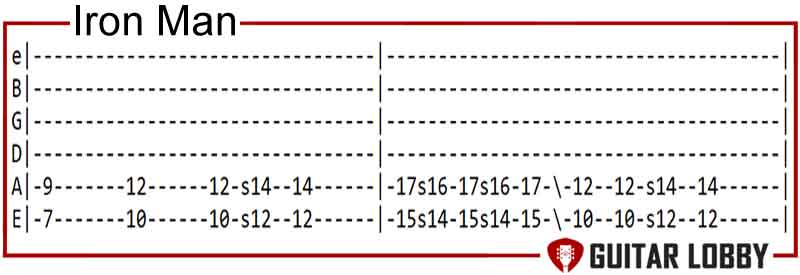
Tabs: See Iron Man by Black Sabbath Tabs Here
While taking a shot at Black Sabbath’s Iron Man, beginners usually skip the killer central riff by Tony Iommi. We’re not going to do that today because it’s not as challenging as it sounds. The ominous riff appears during the verse and is based on just power chords. The moment the vocals kick in, the riff switches from power chords to single lines. You’ll also be able to learn or brush up on techniques like vibrato, where you move and shake your finger on the fret to produce a pitch-quivering effect.
Tips to Practice:
There are quite a few power chords in this one, starting with the B power chord. It’s a good idea to keep your fingers planted and not lift them. Instead, what you should do is slide along the fretboard. Also, listen to the record over and over to know exactly when to hit the notes for that punchy rock vibe.
35. Good Riddance (Time of Your Life) by Green Day
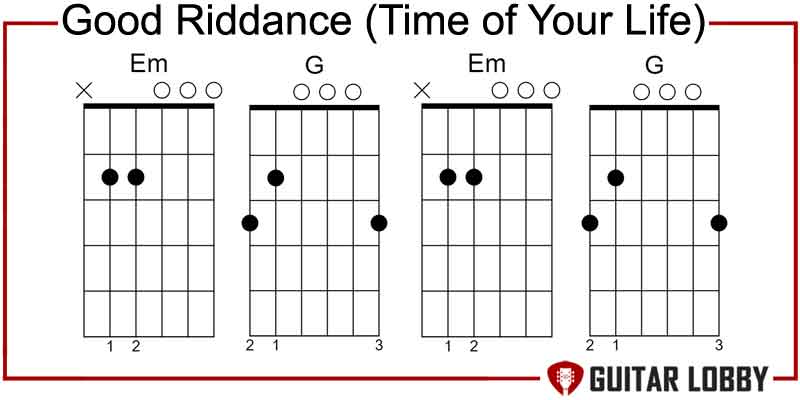
Tabs: See Good Riddance (Time of Your Life) by Green Day Tabs Here
If you want crowd-pulling riffs that are also easy to play, then simply head to Green Day’s vault, like the guitar intro in “Good Riddance” from the band’s Nimrod album. It uses an arpeggio pattern and is the only tricky guitar part in the entire song. But it’s also the most sonically delightful bit. Once you’ve perfected this riff, everything else is smooth sailing and powered by basic power chords and simple strum patterns.
Tips to Practice:
The picking pattern or direction here is D-DU-UDU. You start by playing the G chord by hitting the base note on the 6th string with a downstroke. You’ll play the base note again with a downstroke and then an upstroke on the 2nd string. Next, you’ll hit the open the 3rd string with an upstroke, a downstroke on the open 4th string, and back to an upstroke on the 3rd string. You’ll play the whole thing twice before completing the riff with the Cadd9 chord and D chord with the same picking motion.
36. Breaking the Law by Judas Priest
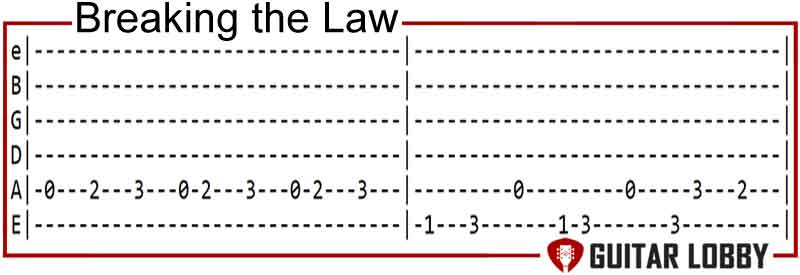
Tabs: See Breaking the Law by Judas Priest Tabs Here
Only a few can match the awesomeness of this minor-key riff from “Breaking the Law.” It just sticks with you, pushing you to grab your guitar and have a go at it no matter what your skill level is. Well, the truth is, the entire track, with its infectious melody and interesting use of police siren and shattered glass sounds, has become a gateway metal song.
Tips to Practice:
This metal riff is simple and a blast to play. All that you should ideally be focusing on is alternate picking. It’s not the easiest technique for newer guitar players, but learning this will make thousands of songs more accessible to you. You’ll only be dealing with the low E and A strings, as shown in the tutorial.
37. Symphony of Destruction by Megadeth
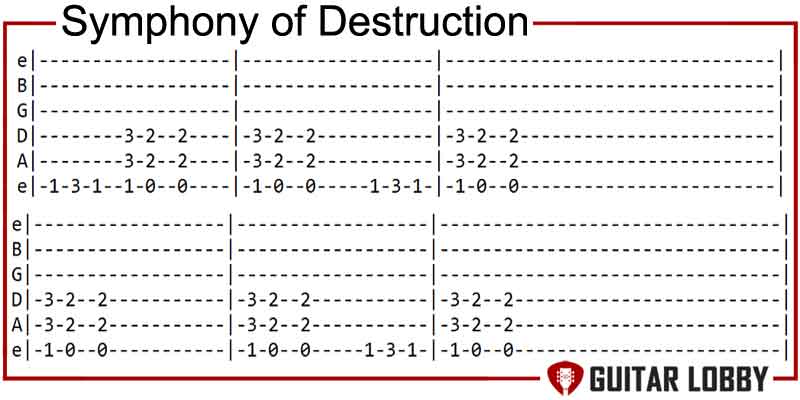
Tabs: See Symphony of Destruction by Megadeth Tabs Here
Now, what is a thrash metal riff doing here? Let’s just say it’s a treat for all the metallers who are new to the guitar but can’t wait to add something from their favorite genre to their arsenal. The riff in Megadeth’s “Symphony of Destruction” is the perfect pick, made up of easy power chords and palm mutes.
Tips to Practice:
This riff is in E minor Phrygian scale, and you’ll be starting with the F power chord followed by an E power chord. After you play the two chords, you’ll be playing single notes. To sound like the record, you’ll have to mute the notes instead of letting them ring. Then you go back to the F and E open power chords.
38. House of the Rising Sun by the Animals
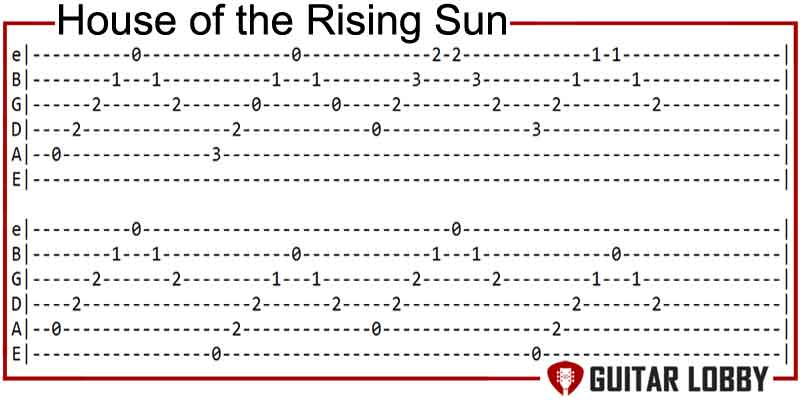
Tabs: See House of the Rising Sun by the Animals Tabs Here
This folk-rock staple has stalked the dreams of every budding guitarist. It’s one of those tunes that can be as easy or complex as you want it to be. You can play it with a distinctive pattern with multiple strings like The Animals do, or go for fingerpicking or flatpicking one string at a time. You can make it even simpler by just strumming the Am, C, D, F, and E chords.
Tips to Practice:
The primary riff is made up of arpeggiated chords: Am, C, D, F, and E. What you need to do is make a chord shape and start picking notes individually in a pattern instead of being strummed. I recommend flatpicking the notes starting with the root note of the chord, which in the case of Am would be the open A string and ending on the high E string. Another thing you should keep in mind is the song’s time signature which goes in 6/8. Familiarizing yourself with the meter by listening to the track a few times and counting along “1, 2, 3, 4, 5, 6” will help you keep pace with the rhythm.
39. One by Metallica
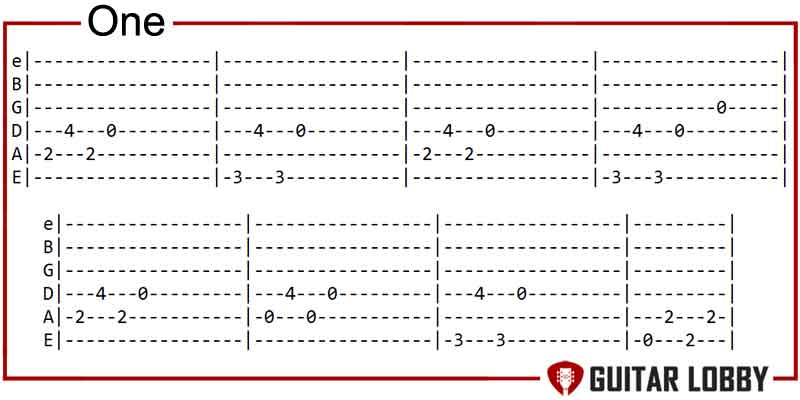
Tabs: See One by Metallica Tabs Here
Another all-time classic metal riff by the thrash titans. In the intro riff of “One, the band swapped their usual high-gain sound for sparkly clean tones, making it instantly identifiable in their thrash metal riff repertoire.
Tips to Practice:
“One” is full of brilliant belters, but the riff that opens the song is one of the easier ones. It’s an arpeggiated picking pattern that’s played on a rhythm guitar. This part comes right before the opening solo by Kirk Hammett. It revolves around power chord shapes, with each bar ending on an open string by removing the pinky finger. It’ll help if you let each note ring and aim for the least possible finger movement, as shown in the tutorial here. This is one of those beginner guitar riffs you simply must learn if you’re a fan of Metallica.
40. I Gotta Feeling by Black Eyed Peas
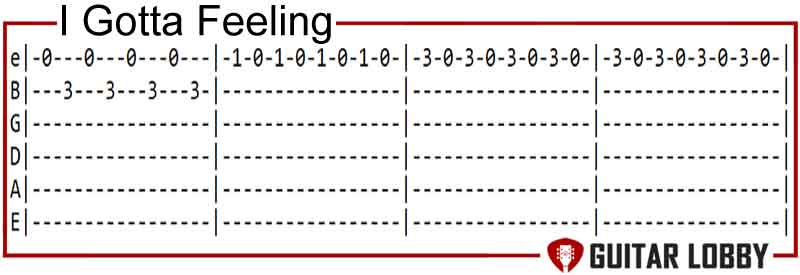
Tabs: See I Gotta Feeling by Black Eyed Peas Tabs Here
If you aren’t too hung up on rock or metal riffs, might I suggest learning this cool dance-pop riff to diversify your repertoire? It opens one of the catchiest party anthems ever and is super easy to play.
Tips to Practice:
There are two sections, the first one that happens over the first two bars is busier and trickier, but the riff is overall pretty straightforward. You’ll be picking two strings together throughout the 2nd string and the 3rd string. The trick here is to pick the two in unison, in a short and swift motion to get one sound instead of two different sounds.
41. Everybody Hurts by R.E.M

Tabs: See Everybody Hurts by R.E.M Tabs Here
With its empathetic and life-affirming message, this soft rock ballad by R.E.M. rocked the charts and became the band’s signature tune. In a recent survey by OnePoll, it was crowned the ultimate tear-jerker by over 2000 adults. Want to learn this tune in the most authentic way possible? Then you’ve got to nail the riff.
Tips to Practice:
The riff uses arpeggios or single notes, as we saw in “House of Rising Sun.” In this case, the chords you’ll be working with are D major and G major. You can use a pick or fingerpick it – whatever works for you. When you down-pick, make sure you keep your forearm stationary and relaxed and let the movement come from the wrist.
42. Rockin’ in the Free World by Neil Young
Tabs: See Rockin’ in the Free World by Neil Young Tabs Here
The sensational riff from Neil Young’s “Rockin’ in the Free World” is designed to fill stadiums! It drives the whole song and has become a part of the cultural fabric, inspiring millions of guitarists around the globe.
Tips to Practice:
The opening riff is easy and a whole lot of fun to play. Simply start by planting the third finger on the 7th fret and play the 5th and 6th strings together and do this for one bar. Make sure you use palm mute throughout the bar and position your hand correctly to nail the sound, as shown in the tutorial. Now barre the 7th fret of the 2nd, 3rd, and 4th strings using your third finger, and then barre the 5th fret of the same strings. You can use an acoustic or an electric to play this part. It’ll sound arena-worthy, regardless.
43. Walk This Way by Aerosmith
Tabs: See Walk This Way by Aerosmith Tabs Here
“Walk This Way” hit two birds with one stone. It introduced mainstream audiences to hip-hop and gave Aerosmith a much-needed career boost. The track features two fantastic riffs, one being easier than the other. I’ll stick to the easy one and leave the better but trickier riff for another day.
Tips to Practice:
The opening or the main riff is kinder to beginners than the one that shows up in the verse. You start by hitting the open A string, then placing the first finger on the 1st fret fn the same string. You can play the next notes by placing your middle finger on the 2nd fret same string and finally the third finger 2nd fret of the 4th string. The riff ends by picking the thickest E string. There’s an even easier way to do this riff involving hammer-ons to smoothen the transition between the notes.
44. La Bamba by Ritchie Valens
Tabs: See La Bamba by Ritchie Valens Tabs Here
Who wouldn’t want the irresistibly catchy intro riff from “La Bamba” in their arsenal? Just unleash it in any setting, and I guarantee you’ll have the crowd grooving. The uplifting rock and roll gem was recorded by Ritchie Valens in 1958. It’s inspired countless covers and many parts of the song and is uncannily similar to an iconic Beatles track: Twist and Shout.
Tips to Practice:
The riff is played over an accessible three-chord rhythm involving C, F, and G chords. It’s a good idea to strum the rhythm and then move to the opening riff to perfect the timing. I also recommend practicing the C major scale, as most of the single notes in the riff come from this scale. Also, try and aim for a clear sound when you pick the note.
45. My Girl by The Temptations
Tabs: See My Girl by The Temptations Tabs Here
Not only is this groovy, upbeat ballad one of Motown’s most loved tunes, it occupies one of the top spots on Rolling Stone Magazine’s genre-spanning 500 Greatest Songs of All Time survey list. The riff does wonders to the song’s sonic quotient, making for a memorable and heartwarming listen.
Tips to Practice:
This is a two-bar riff that plays over a cool bassline. It’s based on the C major pentatonic scale when played in the intro. During the verse, however, you’ll find it oscillating between the C major pentatonic scale and F major pentatonic scale but in the same pattern.
46. Money for Nothing by Dire Straits
Tabs: See Money for Nothing by Dire Straits Tabs Here
If you’re a beginner who cannot wait to learn one of Knopfler’s masterpieces, start with the opening riff in the Grammy-winning “Money for Nothing.” Complex but so unique – it’s totally worth the effort!
Tips to Practice:
There are far easier riffs on this list. After all, we’re talking about the fingerpicking guitar wizard Mark Knopfler. Let’s start by talking about the riff’s distinctive tone. You’ll need a guitar with a humbucker pickup, an overdrive pedal, and a wah-wah in the middle position.
As far as the playing goes, Knopfler employed staccato-style fingerpicking. It might be a good idea to get acquainted with the technique first before attempting the riff. The riff is based on the chord shapes from the G minor pentatonic scale. So, gear up, as you’ll be moving along the neck a lot.
47. Glory Days by Bruce Springsteen
Tabs: See Glory Days by Bruce Springsteen Tabs Here
After a Mark Knopfler riff lesson, you deserve a simple and straightforward riff like the one in Bruce Springsteen’s mega-hit “Glory Days.” It’s based on a standard blues shuffle and is perfectly suited as the first-ever riff for a beginner. Why? Because it’s made up of two power chords: A5 and D5.
Tips to Practice:
You’ll start by strumming the A power chord using the 5th and the 4th strings. Meanwhile, the D power chord will have to hit the 4th and the 3rd string. You might also want to amp up the bluesiness by a note: the 5th string 3rd fret with your middle finger. When you bend it down, instantly move to the D power chord without giving time for the note to return to its original pitch.
48. Song 2 by Blur
Tabs: See Song 2 by Blur Tabs Here
Woo-hoo! This blazing anthem has probably made it to every ear around, but chances are not everyone knows the name of the track. With an ambiguous name like “Song 2,” we can hardly blame anyone. The band wrote and recorded this song to prank the record executives. Turns out, the joke was on them when the studio guys loved it so much they wanted to release it right away. Let’s explore the iconic intro riff in more detail.
Tips to Practice:
Power chords – that’s all you need to nail the energetic riff. No single note picking here, as you’ll just be strumming the chords. You start with a clean tone and an F power chord with the first finger on the 8th fret of the A string and the third finger on the D string 10th fret and play two strums. You then slide down the shape two frets down and strum it thrice. You’ll also be using the 11th, 13th, and even higher frets in the riff. A cutaway guitar would be perfect.
49. Brown Eyed Girl by Van Morrisson
Tabs: See Brown Eyed Girl by Van Morrisson Tabs Here
I am not kidding when I say this folk-rock classic is one of the easiest guitar songs ever written. A simple chord structure with four open chord shapes and an easy strumming pattern has made it popular among beginner guitarists. There’s an intro riff here which isn’t exactly as easily playable as the rest of the song, but learning it will bring you closer to Van Morisson’s original.
Tips to Practice:
I highly recommend learning the rhythm parts before the riff. It’ll help you play the lead riff over the rhythm, especially if you have someone strumming the chords. Start by placing the middle finger on the 8th fret of the 2nd string and the index finger on the 7th fret of the first string and pluck the strings together, which is basically the double stops technique.
Now shift the shape by moving the index finger to the 8th fret of the first string and your ring finger or middle finger to go to the 10th fret of the 2nd string. You don’t have to use the same fingers when moving the shapes, especially if you have a two-fret gap. In this case, using the ring finger instead of your middle finger would make the shift easier. This is just a small part of the lead riff, but pretty much what you’ll be doing for the rest of it.
50. Lose Yourself by Eminem
Tabs: See Lose Yourself by Eminem Tabs Here
An ultra-cool riff and a breeze to play – that pretty much sums up the riff from “Lose Yourself” for you. The punchy, adrenaline-boosting riff draws its energy from power chords and palm mutes.
Tips to Practice:
We start with two notes: the index finger on the 10th fret of the low E and the ring finger on the 12th fret of the A string. This is a D5 power chord. Try to add palm muting to sound like the record. Next, add pinky to the 13th fret of the A string. If you want to sound EXACTLY like the record, you can try stretching your pinky to access the 15th fret of the same string, as shown in the tutorial.
51. Paranoid by Black Sabbath
Tabs: See Paranoid by Black Sabbath Tabs Here
Who wouldn’t want an iconic Tony Iommi riff in their arsenal, especially if you’re still at the beginner learning level? In Paranoid, the legendary riff maker harnesses power chords, double stops, and hammer-ons to create something unforgettable.
Tips to Practice:
Remember, the hammer-on notes in the first measure of the riff are speedy, so practice slowly and build up the pace once you’ve nailed the synchronization between the picking and fretting hand.
52. Wonderwall by Oasis
Tabs: See Wonderwall by Oasis Tabs Here
“Wonderwall” is the rite of passage for every aspiring guitarist. After all, who wouldn’t want that recognizable and crowd-pleasing tune in their setlist? The groovy rhythm, fun riff, and Noel Gallagher’s distinctive croons continue to dominate the campfire and college parties. It’s been nearly thirty years since the release, but the tune is still inescapable!
Tips to Practice:
“Wonderwall” is led by simple open chords and a catchy syncopated rhythm. The riff I want to talk about comes toward the end of the track. Nailing it will help make your performance more authentic. You’ll be dealing with the B and the E strings. No challenging techniques that’ll get in your way here.
53. Boulevard of Broken Dreams by Green Day
Tabs: See Boulevard of Broken Dreams by Green Day Tabs Here
You’ll never run out of great and easily playable riffs in Green Day’s catalog. The riff appears in the intro and relies heavily on power chords – not a surprise since we’re talking about the power chord-loving punk rock royalty here.
Tips to Practice:
This is an out-and-out chord riff built on F5, Ab5, Eb5, and Bb5 power chords. You’ll strum each power chord two times on quarter beats. This riff is recognizable from the first note, but adding the cool tremolo effect would take your sound to the next level – almost as if Billie Joe Armstrong is playing it himself.
54. In My Place by Coldplay
Tabs: See In My Place by Coldplay Tabs Here
An understated gem with a simple melody and wholesome lyrics. “In My Place” is a must-learn for every Coldplay fan, especially those who are just starting out on the guitar. The rhythm parts are straightforward, and so is the lead. The intro riff, in particular, is an absolute joy to play. You can play it on an acoustic or an electric guitar, and it’ll sound just as amazing.
Tips to Practice:
You’ll need a capo on the 2nd fret for the rhythm parts, but you can play the riff without it. If you’re using an electric, set it to a clean tone. There’s no distortion in this one. Finger placement is also key, and you’ll be accessing some higher frets here, like the 12th fret. Make sure you let the notes ring out as much as possible.
55. Communication Breakdown by Led Zeppelin
Tabs: See Communication Breakdown by Led Zeppelin Tabs Here
Led Zeppelin wouldn’t have been as revered as it is without Jimmy Page’s jaw-dropping riffs. He had a knack for creating unforgettable riffs using minor pentatonic scales, octave jumping, alternate tunings, and a host of other techniques. In Communication Breakdown, Page’s riff preceded every other element in the song. The song took shape from the riff.
Tips to Practice:
What’s great about this riff is that it can be simplified down to a beginner level. It’s got easy power chords, and the only hiccup you might face is riffing at Page’s speed, which is lightning-fast. If you want to play at the speed, you must relax your wrist. You’ll also be using palm muting, which goes hand in hand with power chord-based riffs and helps in kicking up the aggression up a notch. Add in some overdrive to nail the tone of this riff to the T.
56. Why’d You Only Call Me When You’re High by Arctic Monkeys
Tabs: See Why’d You Only Call Me When You’re High by Arctic Monkeys Tabs Here
“Why’d You Only Call Me When You’re High” might not be the easiest Arctic Monkeys song to play on a guitar. But you’ll not find a simpler Alex Turner riff than this one. Every beginner can play the riff even if they aren’t yet ready to handle the trickier bits.
Tips to Practice:
You only have eight notes in this riff, which first shows up in the intro and then again through the verses and chorus. The best part is that all notes can be played using just your first finger. To capture the tone of Turner’s guitar, you’ll need a short slapback delay of about 120ms-200ms, a clean tone, and a bit of palm muting.
57. I See Fire by Ed Sheeran
Tabs: See I See Fire by Ed Sheeran Tabs Here
Ed Sheeran wrote and recorded this captivating folky ballad for the 2013 fantasy adventure drama The Hobbit: The Desolation of Smug. And he did all of it in less than a day. The minor key riff in the intro is eerie and does well in elevating the dark, haunting vibe of this otherwise softly strummed guitar song.
Tips to Practice:
There are two ways to play the opening riff. If you want to learn the record’s way, be prepared to do some serious fingerpicking. There’s another way, while it may not sound exactly like the riff in the song, it captures the essence of the original. You’re looking at three chords to nail the intro: Em, C, and D, and you’ll need a capo on the 6th fret.
To play the riff in the easiest way possible, just strum the Em and C chords on the 1st and the 3rd beat with percussive muting on the 2nd and the 4th beat. The second bar of the riff will have you strumming the D chord twice and the Em again, with percussive muting in between.
58. Rumble by Link Wray
Tabs: See Rumble by Link Wray Tabs Here
This ‘50s rock classic by Link Wray was called “the best instrumental tune ever” by none other than the legendary Bob Dylan. Wray’s fascinating use of power chords took the world by storm. It was also the first-ever track to use distortion and tremolo effects. Today, we’ll look at the song’s equally awesome melody riff.
Tips to Practice:
This descending riff is a masterclass in using the E minor pentatonic scale, which is often the first scale taught to a new guitarist. In this song, you’ll be playing the notes of the scale from the highest note to the lowest, starting with the ring finger on the high E string 3rd fret. If you really want to ace this riff, I recommend practicing alternate picking to go through the pentatonic sequence at the desired speed.
59. Don’t Fear the Reaper by Blue Oyster Cult
Tabs: See Don’t Fear the Reaper by Blue Oyster Cult Tabs Here
It’s time for an arpeggiated riff that, together with harmonized vocals and existential lyrics, proved to be a career-defining moment for the hard rock band. But the catchiest element of the song is the band’s clever use of a cowbell which elevates the overall creepiness of the tune.
Tips to Practice:
This riff utilizes notes of three chords: A5, G, and F, with a 6th and a 9th note to the triad. These chords will be played as arpeggios, just like we saw in “House of the Rising Sun.” Let the notes ring out and practice it slowly before picking up the pace.
60. Owner of a Lonely Heart by Yes
Tabs: See Owner of a Lonely Heart by Yes Tabs Here
Arguably Yes’s biggest hit, “Owner of a Lonely Heart,” is home to a catchy and easily playable riff. It was the first and the only single by the famous prog-rock band to make it to the top spot. You can even play it on one string, but the way the band plays it is also quite straightforward. No fancy techniques here, and all you need to know are the basics of power chords and palm muting.
Tips to Practice:
The distorted riff appears in the intro and other points in the song. It’s built using four power chords: A5, B5, C5, and D5. But there’s a variation in the power chords played at the start of the song, like when the A power is played with the open E string in the bass to beef up the sound. You should aim to strum with speed and precision. You’ll also be muting the chords using the palm muting technique.
60. Message in a Bottle by the Police
Tabs: See Message in a Bottle by the Police Tabs Here
Sting-fronted Police have many reggae-injected rock gems in their discography. The chart-topping “Message in a Bottle” from the band’s Reggatta de Blanc album is an excellent example of that style. The track also occupies the 65th rank in Rolling Stone’s list of “100 Greatest Guitar Songs of All Time.” And the riff we’re about to break down below is one of the reasons why it’s on the wishlist of every rock guitarist.
Tips to Practice:
The riff involves some pretty stretchy chords. You’ll be plucking the notes one by one, playing the chords as arpeggios. If this is too tricky and stretchy, you can use your third finger in place of the pinky to pluck the stretchy note by moving your fingers around. It might not sound exactly the same but a whole lot easier than Summers’ version. Don’t forget to add the chorus effect to replicate the retro vibe of the original.
61. Hair of the Dog by Nazareth
Tabs: See Hair of the Dog by Nazareth Tabs Here
Scottish hard rock band Nazareth’s sound, didn’t belong to the ‘70s. They were ahead of their time, combining fierce riffing and heavy-metal howling with infectious pop hooks. The title track from their Hair of the Dog album has the classic Nazareth trappings, including an energetic opening riff.
Tips to Practice:
This main riff features in the intro after the drums and the cowbell. It also comes up in the verse but sounds slightly different. The riff spans two measures, with the first bar starting on the open low E or the 6th string. It sounds a lot like the Beatles’ “Day Tripper,” which we discussed at the start of this list. Once you’re through with that riff, you should be able to get this under your fingers in no time.
62. T.N.T by AC/DC
Tabs: See T.N.T by AC/DC Tabs Here
Explosive as the title and super easy to play are reasons enough why this AC/DC riff should be a part of your arsenal, pronto. Created by one of the most inventive rhythm guitarists, Malcolm Young, this riff is made up of open power chords and paired with standard rock techniques to project this huge, aggressive sound.
Tips to Practice:
The easiest way to play this riff is one string, the thickest E string, and with the index finger and the ring finger to pick the notes. If you’re more serious about nailing the AC/DC sound, then you’ll need to play one-fingered E5, A5, and G5 power chords with mutes. The muting will help you capture Malcolm’s cool riff rhythm.
63. Hero by Enrique Iglesias
Tabs: See Hero by Enrique Iglesias Tabs Here
Yes, there are plenty of pop songs with fantastic guitar riffs. Take Enrique Iglesias’ smash hit “Hero,” which kicks off one of the most beautiful fingerstyle riffs I’ve ever heard. The entire tune is made up of only four chords which are fingerpicked in the riff and strummed in the rest of the song. The chords are G, Em7, Cadd9, and Dsus4.
Tips to Practice:
You don’t need to be an expert in fingerpicking to play this riff. Remember to use your thumb to play the 6th, 5th, and 4th strings and your first, second, and third fingers to play the 3rd, 2nd, and first strings – in that order. In the riff, you start by picking the base of the note of the G chord and follow it by picking the 1st string, 2nd string, and third string. You do this twice before moving on to the Em7 chord.
65. The Chain by Fleetwood Mac
Tabs: See The Chain by Fleetwood Mac Tabs Here
Lindsey Buckingham is hailed for creating riffs that sound as if more than one guitar is at work. He uses intricate fingerpicking patterns and unleashes them on the awe-struck crowd at blazing speeds.
Tips to Practice:
The intro in “The Chain” is perhaps the most beginner friendly a Fleetwood Mac riff can get. You start on the open A string and then move straight to the notes from the C major scale. This is a bass riff but works well on the thicker strings of an acoustic guitar. For the lead part that’s played over this riff, plant the first finger on the 5th fret on the B string and it alongside the open high E string. This has to happen at breakneck speed with small swift movements. In other words, add it to your daily practice routine to build speed and accuracy.
Final Thoughts:
There you have it! Some of the most iconic guitar riffs are also easy to play. Adding a handful of these to your arsenal will give you a good grounding in palm muting, power chords, scales, hammer-ons, alternate picking, arpeggios, and much more. If you find yourself getting overwhelmed with some of the riffs here, it’s perfectly okay to park them for later. Remember to work on accuracy when it comes to chord fingerings, coordination between picking and fretting hand, and picking direction. Speed will follow.

My name is Chris and I’ve had a passion for music and guitars for as long as I can remember. I started this website with some of my friends who are musicians, music teachers, gear heads, and music enthusiasts so we could provide high-quality guitar and music-related content.
I’ve been playing guitar since I was 13 years old and am an avid collector. Amps, pedals, guitars, bass, drums, microphones, studio, and recording gear, I love it all.
I was born and raised in Western Pennsylvania. My background is in Electrical Engineering, earning a Bachelor’s degree from Youngstown State University. With my engineering experience, I’ve developed as a designer of guitar amplifiers and effects. A true passion of mine, I’ve designed, built, and repaired a wide range of guitar amps and electronics. Here at the Guitar Lobby, our aim is to share our passion for Music and gear with the rest of the music community.
